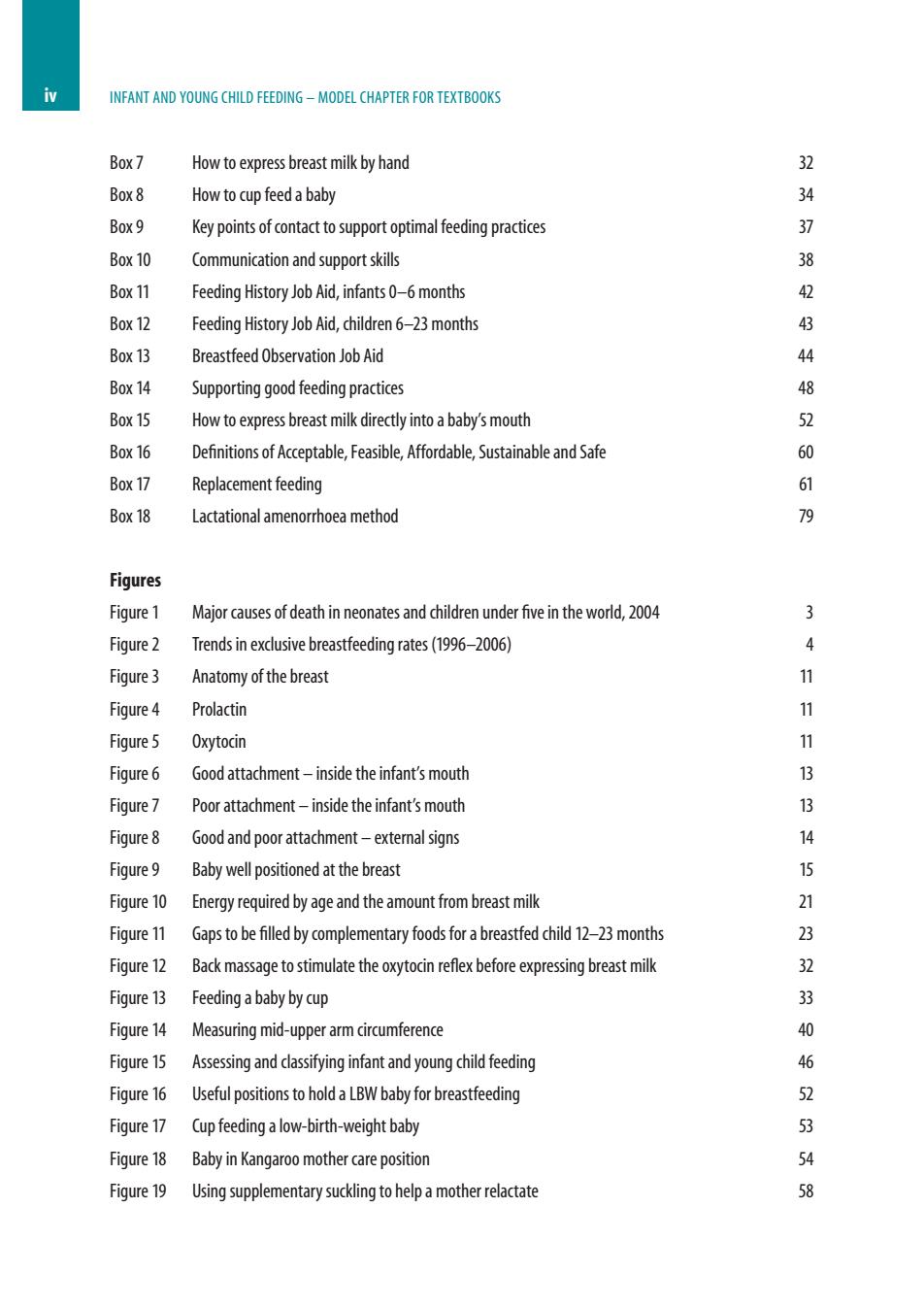正在加载图片...

INFANT AND YOUNG CHILD FEEDING-MODEL CHAPTER FOR TEXTBOOKS Box7 How to express breast milk by hand 32 Box8 How to cup feed a baby 34 Box9 Key points of contact to support optimal feeding practices 37 Box10 Communication and support skills 38 Box 11 Feeding History Job Aid,infants 0-6 months 42 B0X12 Feeding History Job Aid,children 6-23 months 43 Box 13 Breastfeed Observation Job Aid 44 Box 14 Supporting good feeding practices 48 Box 15 How to express breast milk directly into a baby's mouth 52 Box16 Definitions of Acceptable,Feasible,Affordable,Sustainable and Safe 60 Box 17 Replacement feeding 61 Box18 Lactational amenorrhoea method 79 Figures Figure 1 Major causes of death in neonates and children under five in the world,2004 3 Figure 2 Trends in exclusive breastfeeding rates(1996-2006) Figure3 Anatomy of the breast 11 Figure 4 Prolactin 11 Figure 5 Oxytocin 11 Figure 6 Good attachment-inside the infant's mouth 13 Figure 7 Poor attachment-inside the infant's mouth 13 Figure8 Good and poor attachment-external signs 14 Figure9 Baby well positioned at the breast 15 Figure 10 Energy required by age and the amount from breast milk 21 Figure 11 Gaps to be filled by complementary foods for a breastfed child 12-23 months 23 Figure 12 Back massage to stimulate the oxytocin reflex before expressing breast milk 32 Figure 13 Feeding a baby by cup 33 Figure 14 Measuring mid-upper arm circumference 40 Figure 15 Assessing and classifying infant and young child feeding 46 Figure 16 Useful positions to hold a LBW baby for breastfeeding 52 Figure 17 Cup feeding a low-birth-weight baby 53 Figure 18 Baby in Kangaroo mother care position 54 Figure 19 Using supplementary suckling to help a mother relactate 58iv Infant and Young Child Feeding – Model Chapter for textbooks Box 7 How to express breast milk by hand 32 Box 8 How to cup feed a baby 34 Box 9 Key points of contact to support optimal feeding practices 37 Box 10 Communication and support skills 38 Box 11 Feeding History Job Aid, infants 0–6 months 42 Box 12 Feeding History Job Aid, children 6–23 months 43 Box 13 Breastfeed Observation Job Aid 44 Box 14 Supporting good feeding practices 48 Box 15 How to express breast milk directly into a baby’s mouth 52 Box 16 Definitions of Acceptable, Feasible, Affordable, Sustainable and Safe 60 Box 17 Replacement feeding 61 Box 18 Lactational amenorrhoea method 79 Figures Figure 1 Major causes of death in neonates and children under five in the world, 2004 3 Figure 2 Trends in exclusive breastfeeding rates (1996–2006) 4 Figure 3 Anatomy of the breast 11 Figure 4 Prolactin 11 Figure 5 Oxytocin 11 Figure 6 Good attachment – inside the infant’s mouth 13 Figure 7 Poor attachment – inside the infant’s mouth 13 Figure 8 Good and poor attachment – external signs 14 Figure 9 Baby well positioned at the breast 15 Figure 10 Energy required by age and the amount from breast milk 21 Figure 11 Gaps to be filled by complementary foods for a breastfed child 12–23 months 23 Figure 12 Back massage to stimulate the oxytocin reflex before expressing breast milk 32 Figure 13 Feeding a baby by cup 33 Figure 14 Measuring mid-upper arm circumference 40 Figure 15 Assessing and classifying infant and young child feeding 46 Figure 16 Useful positions to hold a LBW baby for breastfeeding 52 Figure 17 Cup feeding a low-birth-weight baby 53 Figure 18 Baby in Kangaroo mother care position 54 Figure 19 Using supplementary suckling to help a mother relactate 58